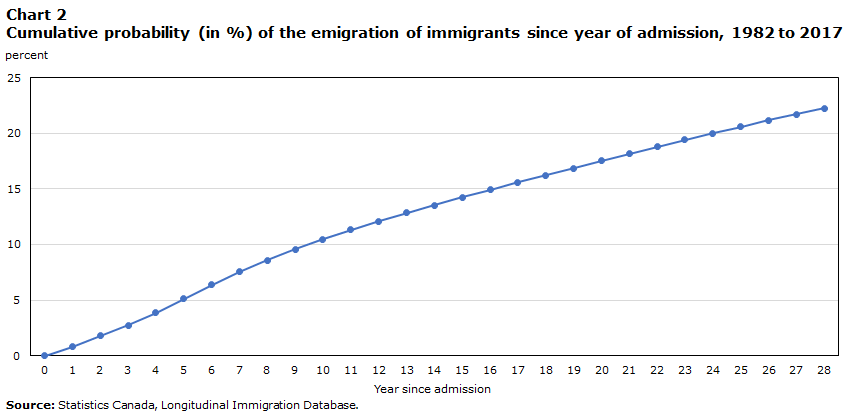A recent in-depth examination of immigration and emigration trends spanning over 35 years in Canada has been unveiled by Statistics Canada, shedding light on the reasons behind the departure of a notable percentage of immigrants within their initial years in the country.
According to the national statistics agency, the findings revealed that 5.1% of immigrants who arrived in Canada between 1982 and 2017 chose to emigrate within the first five years of their arrival. Interestingly, this percentage increased to 17.5% when examined two decades after their admission into the country.
Detailed data analysis further highlighted that the likelihood of emigration peaked between three to seven years after immigrants landed in Canada, reaching its zenith at nearly 1.4% during the fourth and fifth years.

Delving into the factors influencing this trend during the fourth and fifth years, experts have put forth several hypotheses. Firstly, this period may coincide with the duration immigrants typically spend trying to assimilate into Canadian society—searching for employment, securing housing, and adapting to the Canadian way of life. Some immigrants may opt to emigrate during this phase, possibly due to challenges related to labor market integration.
A second significant factor could be the evolving timeline for obtaining Canadian citizenship, a process that has undergone substantial changes in the past decade. While the previous requirement allowed citizenship acquisition by staying in Canada for 183 days per year over four of the six years preceding the application, the current regulations demand a physical presence of at least 1,095 days (three years) during the five years preceding the application date.
Experts posit that the allure of Canadian citizenship, coupled with its associated benefits, such as the ability to return to Canada at any time and receive government assistance in emergencies abroad, may contribute to the migration strategy of some immigrants.
The study also indicates that the probability of emigrating surpasses 10% a decade after admission into Canada. Remarkably, slightly over one in five immigrants were found to have emigrated 25 years after their initial admission to Canada, suggesting that while annual emigration rates are relatively low, they become a more significant phenomenon over the long term.
In a noteworthy development, Statistics Canada reported the fourth-largest departure of residents in 73 years during the third quarter of December 2023. Over 32,000 individuals left the country, marking a 3% increase in emigration. The accompanying graph visually represents the quarterly outflow of Canadian emigrants—those departing the country to immigrate elsewhere.
Migration Dynamics: Over 15% of Immigrants Depart Canada Within Two Decades, Highlights StatsCan Study
A recent study from Statistics Canada reveals that more than 15% of immigrants who arrived in Canada between 1982 and 2017 chose to leave the country within 20 years of their admission, sparking discussions about immigration policies amid ongoing calls to lower immigration intake.
The study indicates that the likelihood of immigrants leaving is most pronounced in the first few years after admission, peaking at around 1.4% during the fourth and fifth years. This probability gradually decreases over time, ranging from 0.6% to 0.7% after 15 years.
Various factors may contribute to these departures and their timing, with experts suggesting integration challenges as a potential reason. Julien Berard-Chagnon, a demographer with Statistics Canada, emphasizes that the three to seven years after admission provide immigrants with a crucial period for adapting to Canadian society, finding employment, securing housing, and adjusting to the Canadian climate.
The unexpected number of immigrants leaving the country, as highlighted by RBC economist Claire Fan, underscores the importance of addressing gaps in Canada’s labor force and ensuring a more productive and satisfying work environment for newcomers.
The study reveals fluctuations in the decision to emigrate based on the admission period, with immigrants arriving in the late 1980s and early 1990s showing a higher likelihood of leaving, surpassing 15% within 20 years. Conversely, those who arrived since 2000 display a lower likelihood of emigration, with nearly 5% leaving within five years and 10% within a decade.
Institute for Canadian Citizenship CEO Daniel Bernhard sees the study as a confirmation of their own “Leaky Bucket” study, released in October 2023, which highlighted a surge in immigrant departures in 2017 and 2019, particularly among highly skilled individuals. Investors and entrepreneurs are identified as the most likely admission classes to emigrate within 20 years, alongside self-employed and skilled worker immigrants, with slightly more than 20% leaving after two decades.
Bernhard emphasizes the importance of ensuring positive early experiences for immigrants to encourage them to stay. He points out that skilled workers, investors, and entrepreneurs are among those most likely to leave, underlining the need for a comprehensive approach to address integration challenges.
Claire Fan acknowledges the impact of housing and other factors on immigration outcomes, emphasizing the necessity of not only facilitating entry into the country but also ensuring proper post-arrival measures to foster integration and satisfaction among immigrants.















